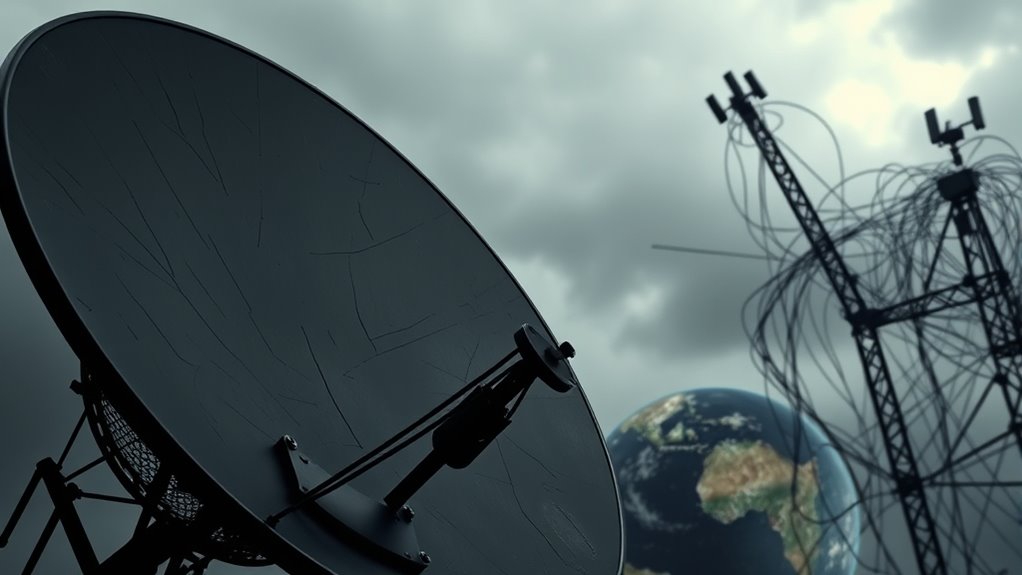Satellite jamming is an invisible threat that can severely disrupt your communications by flooding satellite signals with noise or false signals. It’s a covert tactic used by adversaries, often through ground-based jammers or drones, to isolate military and civilian systems from essential information. This interference can cause delays, confusion, and even data loss. Understanding how these tactics work and how to protect against them is critical—continue with this information to learn more.
Key Takeaways
- Satellite jamming disrupts both military and civilian communications by overpowering legitimate satellite signals with noise or false signals.
- It is a covert electronic warfare tactic used to deny adversaries access to critical satellite-based information.
- Techniques involve ground-based, drone, or satellite sources targeting specific frequency bands for interference.
- Countermeasures include anti-jamming technologies, resilient systems, encrypted signals, and adaptive communication protocols.
- As a stealthy threat, satellite jamming impacts global security, commerce, and everyday communications, emphasizing the need for resilience and innovation.

Have you ever wondered how hostile entities disrupt satellite communications? It’s a question that reveals just how vulnerable our interconnected world can be. Satellite jamming is a covert, yet increasingly common threat that hampers signals and cripples networks that rely on satellite technology. When these entities target satellites, they use methods designed to create signal interference, effectively drowning out legitimate transmissions with powerful noise or false signals. This disruption can be temporary or sustained, depending on the attacker’s intent and resources. It’s not just petty sabotage; often, it’s a calculated part of military tactics aimed at gaining strategic advantages. By jamming enemy communications or preventing adversaries from using satellite data, military forces can manipulate the battlefield, blind opponents, or protect their own operations from interception. These tactics involve sophisticated technology that can flood a satellite’s reception with noise, rendering it unable to distinguish genuine signals from interference. This interference can be achieved with ground-based jammers, drones, or even other satellites, making it a flexible and scalable threat. Moreover, the ability to develop resilient systems is crucial, as advanced countermeasures are continually being refined to combat these disruptions.
In military contexts, satellite jamming serves as a force multiplier, allowing hostile groups to deny adversaries access to critical information or disable command and control systems. By obscuring signals, they can create confusion, delay responses, or even cause miscommunications that lead to tactical errors. The use of signal interference in this way is often part of broader electronic warfare strategies, which aim to degrade an opponent’s situational awareness without engaging in direct combat. The effectiveness of these tactics hinges on the attacker’s ability to precisely target specific frequency bands used by military and civilian satellites. They exploit vulnerabilities in satellite receivers, flooding them with enough noise to overpower legitimate signals. This can be particularly disruptive during military exercises or conflicts, where reliable communication is vital.
Knowing how these tactics work highlights the importance of developing resilient satellite systems and countermeasures. Governments and organizations invest heavily in anti-jamming technology, signal encryption, and adaptive communication protocols to stay ahead of such threats. But as technology advances, so do the methods of those aiming to disrupt it. The battle over satellite signals is ongoing, with signal interference being a potent tool in the arsenal of electronic warfare. Understanding these tactics helps you grasp how invisible threats like satellite jamming can have real-world consequences, threatening global security, commerce, and everyday communication. Additionally, cultivating awareness of creative practice can foster innovative solutions and resilience in the face of emerging technological threats.
Frequently Asked Questions
How Can Satellite Jamming Be Detected Early?
You can detect satellite jamming early by implementing continuous signal monitoring and anomaly detection systems. These tools track the integrity of your signals, identifying unusual patterns or disruptions that indicate jamming attempts. By setting up automated alerts for anomalies, you stay alert to potential threats, allowing you to respond quickly. Regularly updating your detection methods and analyzing signal behavior helps you stay ahead of malicious interference, ensuring your communications remain secure.
What Are the Legal Consequences of Satellite Jamming?
Imagine your signals hit a wall—satellite jamming can lead to serious legal repercussions. If you’re caught, you could face international sanctions, fines, or criminal charges, depending on your jurisdiction. Governments see jamming as a threat to global security, so they often respond with strict penalties. You might even be blacklisted from future communications projects. Stay within legal boundaries to avoid these consequences and keep your operations secure and compliant.
Which Countries Are Most Involved in Satellite Jamming Activities?
You should know that countries like China, Russia, and North Korea are most involved in satellite jamming activities. They often use regional interference as a tool for strategic deterrence, disrupting signals to weaken opponents or safeguard their interests. These nations focus on developing jamming capabilities to control information flow, making them key players in the ongoing satellite jamming landscape. Understanding their motives helps you grasp the broader implications for global communications security.
How Does Satellite Jamming Affect Civilian Communications?
You might think satellite interference only affects military or government signals, but it also impacts civilian communications. When signals get disrupted by jamming, your internet, TV, and mobile services can experience interruptions or degraded quality. This signal disruption makes it harder to stay connected, especially during emergencies. So, even if you’re not aware of satellite jamming, it directly threatens your daily communication needs and access to essential information.
What Technology Is Used to Defend Against Satellite Jamming?
You can defend against satellite jamming by using advanced encryption protocols that secure your signals from interference. Signal redundancy also plays a key role, as transmitting multiple copies over different frequencies guarantees communication persists even if one signal is jammed. These technologies work together to protect your data, maintain reliable connections, and ensure your communications stay secure, even in the face of malicious attempts to disrupt satellite signals.
Conclusion
As you rely on satellite communications daily, it’s no coincidence that this invisible threat quietly lurks in the background. Satellite jamming can disrupt everything from your GPS to global banking. Just as technology connects us seamlessly, it’s vulnerable to interference we often overlook. Stay aware, because the next time your signal drops unexpectedly, it might be more than just bad weather — it could be a jamming attempt, reminding us how fragile our digital world truly is.









